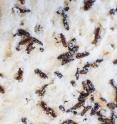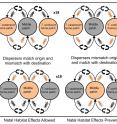Where were you born? Origin matters for species interactions
Related images
(click to enlarge)
An oft-quoted proverb says it takes a village to raise a child, and new research from ecologists at Rice University and Louisiana State University suggests that a similar concept may be at work in natural ecosystems. The research, which appears in this week's Early Edition of the Proceedings of the National Academy of Sciences, finds that the early life experiences of individual animals can have wide-reaching impacts on entire species. "When individuals come to a new environment, their performance and probability to succeed are influenced by what they experienced earlier in their lives," said Volker Rudolf, an associate professor of biosciences at Rice and co-author of the new study, which examined whether "carryover effects" from past environments could have a notable impact on the distribution of species in an ecosystem.
Study co-author Benjamin Van Allen, a postdoctoral research assistant at LSU and former Rice graduate student, said, "Our findings indicate that wildlife ecologists and habitat managers should consider how they are conducting species reintroductions and species relocations. We found that failing to account for past experiences of individuals could result in incorrect assumptions about how many individuals a particular ecosystem can support as well as which species will thrive and which will struggle."
In classical ecological theory, carryover effects of past conditions are often ignored. For example, Rudolf said, if ecologists are interested in exploring how an invasive species or a reintroduced species might fare in a new habitat, they would typically list the species that are already there, determine how each of those species interacts with one another and with the new species and then calculate the expected population dynamics accordingly.
"There's an implicit assumption that every species' success or failure will be solely determined by the conditions of the new habitat," Rudolf said. "Everything that happened before they arrived is thrown out. Yet common sense -- and previous findings from other studies -- tells us that individuals can be very different if they come from disparate environments."
To test whether ignoring the origin of dispersing individuals might skew population dynamics predictions, Van Allen and Rudolf designed a series of lab experiments with the goal of eliminating all variables except carryover effects. Their study involved two species of flour beetles, Tribolium castaneum and Tribolium confusum, ant-sized pests that have been invading human granaries for more than 4,000 years. Each species can infest and live in a range of stored grains but they both thrive more in some types and struggle to persist in others. The two species have been closely studied for more than 50 years and serve as a classical model system to study competition. For example, T. castaneum typically outcompetes T. confusum in a good habitat, but T. confusum performs slightly better under some types of adverse conditions.
In the experiments at Rice, pill-bottle-sized canisters with enough flour to support several hundred of beetles were used to represent distinct "patches" of habitat. Three patches containing either oat flour or wheat flour were used to represent a single "landscape" in which individuals might move between patches at different rates. Oat flour represented a low-quality patch and wheat flour a high-quality patch. In half of the experiments, two of the three patches in each landscape were high-quality, and in the others, two of the three were low-quality. Researchers introduced both species from opposing sites into this landscape and simulated different levels of movement between neighboring patches every month to study the resulting population dynamics and spatial distribution.
Van Allen said the setup ensured that the two species were in direct competition from the first movement onward, and control tests using the same landscape designs were conducted with no carryover effects for comparison.
"Some of the results were counterintuitive," Van Allen said. "For example, the landscapes with carryover effects produced significantly higher populations, sometimes almost 20 percent higher, than ones without carryover effects. Looking at the interactions between species was also key because we saw much stronger results than we had in previous experiments like this with just a single species switching between high and low patches."
Rudolf said the research clearly shows that carryover effects can have important consequences and that habitat managers should be thinking about how the prior experiences of individuals can influence their performance when they enter a new environment.
"The results have implications for landscape management because individuals typically move between different landscapes and patches in nature," Rudolf said. "That means that if you start monkeying around with one habitat, you could change another habitat that you didn't even think about. So we really need to think about the potential far-reaching regional consequences of local actions and not simply focus on the immediate habitat."
Source: Rice University
Other sources
- Where were you born? Origin matters for species interactionsfrom Science DailyMon, 13 Jun 2016, 21:01:07 UTC
- Where Were You Born? Origin Matters for Species Interactionsfrom Newswise - ScinewsMon, 13 Jun 2016, 20:31:04 UTC
- Where were you born? Origin matters for species interactionsfrom PhysorgMon, 13 Jun 2016, 19:11:03 UTC


